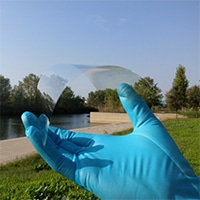Dec 20 2016
One of the principal elements of new generation electronic and optoelectronic devices—such as displays, photovoltaic cells, light emitting diodes, smart phones, and so on—are transparent conductors (TCs). A large portion of the current technology relies on the usage of indium tin oxide (ITO) as a transparent conducting material. Although ITO exhibits various extraordinary properties such as low resistance and large transmission, it is expensive to produce, has to be processed under high temperatures, and has no mechanical flexibility.
 Flexible transparent conductor. Credit: ICFO
Flexible transparent conductor. Credit: ICFO
Large-scale research work is ongoing to find alternative TC materials that can be definitively substituted in the place of ITO, specifically in terms of device flexibility. Although scientists have examined materials such as metal nanowires, conducting polymers, Al-doped ZnO (AZO), ultrathin metals, carbon nanotubes and most recently graphene, none of the materials were found to exhibit optimal properties to make them eligible to be substituted for ITO.
At present, ultrathin metal films (UTMFs) have been found to exhibit very low resistance, despite the fact that their transmission is also low without the addition of antireflection (AR) overcoat and undercoat layers to the structure. ICFO scientists Rinu Abraham Maniyara, Vahagn K. Mkhitaryan, Tong Lai Chen, and Dhriti Sundar Ghosh, headed by Valerio Pruneri, ICREA Prof at ICFO, have created a room temperature processed multilayer TC that optimizes the antireflection properties to acquire high optical transmissions and low losses, and also possessing higher mechanical flexibility. The outcomes of their research have been published in a recent paper in the journal Nature Communications.
The ICFO researchers applied a TiO2 undercoat layer and an Al-doped ZnO overcoat of precise thicknesses onto a highly conductive Ag UTMF. They used destructive interference to demonstrate that the proposed multilayer structure led to an optical transmission greater than 98% and an optical loss of nearly 1.6% in the visible. This outcome is a record fourfold enhancement in figure of merit over ITO and also exhibits on-par mechanical flexibility when compared to ITO.
The findings of the research point toward the potential usage of this multilayer structure in future technologies whose goal is to achieve highly flexible and efficient electronic and optoelectronic devices.